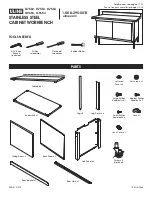
User Manual
–
BMOD0010 E160 B02
–
Doc. No. 3003406.1
© 2022 Maxwell Technologies, Inc.
Page 5
Electrical
WARNING
CAUTION
To avoid arcing, the energy storage module should be in a
discharged state and the system power disconnected during
installation. The module is shipped discharged and with a shorting
wire. The shorting wire should be removed prior to installation of
electrical connections.
WARNING
CAUTION
To provide the lowest possible ESR the energy storage modules are
not fused. Care should be taken within the application to prevent
excessive current flow. Excessive current and/or duty cycle will
result in overheating the module and cause irreparable damage.
Please consult the specific data sheet for each module for current
and duty cycle capabilities.
The power output terminals of the modules consist of M5 screw terminals intended to mate with
spade or ring terminals. Ensure that interconnect wire is of sufficient gauge to carry the system
current. The modules may be connected in series for higher voltages. As mentioned earlier, the
maximum torque is 4 Nm.
The BMOD0010 modules have a center-tap terminal that can be used to compare the voltage of the
upper half of the ultracapacitor array with that of the lower half as a diagnostic for imbalance. This
mid-point voltage is accessible through the M4 monitoring terminals as illustrated in Figure 2.
The
current drawn from the center tap should not exceed 10μA
. Drawing currents in excess of this
amount can create imbalance within the module. The maximum torque for this M4 terminal is 2
Nm. The energy storage modules have low Equivalent Series Resistance (ESR). As a result, the
resistance of the wires connecting the energy storage module to the application can easily exceed
the ESR of the module. Connection of modules in series or parallel should utilize the same gauge
wire as determined for final output connections. When connecting in series connect the positive
output terminal of one module to the negative output terminal of the next module. Two possible
series orientations are illustrated in Figure 3. Possible parallel orientations are shown in Figure 4.





























